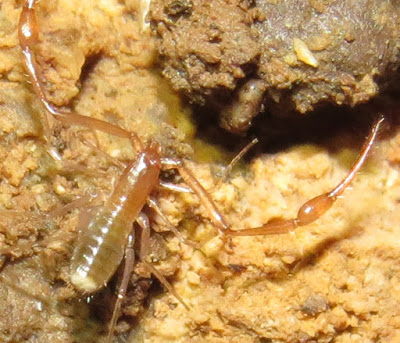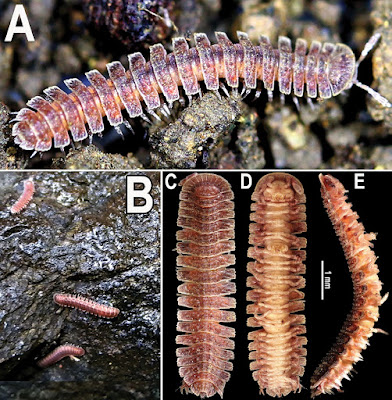[Most Recent Entries] [Calendar View]
Tuesday, April 2nd, 2019
| Time | Event | ||
| 2:41a | [Arachnida • 2019] Typhloroncus guatemalensis • A New Troglobitic Species of Typhloroncus (Pseudoscorpiones: Ideoroncidae) from Guatemala
Abstract Typhloroncus guatemalensis sp. n., found in Gruta de Lanquín, a limestone cave located in the municipality of Lanquín (Alta Verapaz, Guatemala), is described. It can be distinguished from the congeneric species mainly by the presence of lanceolate ventrodistal telotarsal setae on all legs; by the chelal teeth, which exhibit a varied morphology; by the number of trichobothria (30‒32); and by its measurements. Typhloroncus guatemalensis sp. n. represents the first record for the genus in Guatemala and is considered to be troglobitic. Keywords: Pseudoscorpiones, taxonomy, pseudoscorpions, troglomorphism, cave Typhloroncus guatemalensis Ana Clara M. Viana and Rodrigo L. Ferreira. 2019. A New Troglobitic Species of Typhloroncus (Arachnida: Pseudoscorpiones: Ideoroncidae) from Guatemala. Zootaxa. 4576(2); 288–300. DOI: 10.11646/zootaxa.4576.2.4 | ||
| 3:16a | [Diplopoda • 2019] Cryptocorypha enghoffi • A New Species of the Millipede Genus Cryptocorypha Attems, 1907 (Polydesmida, Pyrgodesmidae), from northern Thailand
Abstract The millipede family Pyrgodesmidae and the genus Cryptocorypha are recorded from Thailand for the first time, being represented there by Cryptocorypha enghoffi sp. n. The new species is distinguished by the evident apicodorsal trichostele on the last tibia of both sexes and the gonopodal telopodite being particularly complex, quadripartite, consisting of the longest, mesal, suberect solenomere branch; a slightly shorter, similarly slender, acuminate endomere branch tightly appressed to the solenomere; a somewhat shorter, caudal, strongly curved, armed exomere process; and a very distinct, low, lateral, sac-shaped velum at their base. This situation strongly resembles the one observed in the geographically closest C. perplexa Golovatch & VandenSpiegel, 2015, from Myanmar, but the shapes and armament of all outgrowths of the gonopodal telopodite are clearly different. A key to all three Cryptocorypha pecies known from Indochina or Myanmar and an updated checklist of all 21 species of the genus are provided. Keywords: Chiang Mai, Diplopoda, Henrik Enghoff, Huai Hong Khrai Royal Development Study Centre Family Pyrgodesmidae Silvestri, 1896 Genus Cryptocorypha Attems, 1907 Diagnosis: The genus is characterized within Pyrgodesmidae by an unusually flat body with 19 or 20 segments (either in both sexes or 19 solely in the male) and only a slightly convex dorsum, coupled with 6+6 faint lobulations or 11 radii at a regularly rounded anterior margin of a flabellate collum that fully covers the head from above; usually three or four (rarely five) more distinct lobulations at the lateral margins of poreless and pore-bearing paraterga, respectively; a normal pore formula (5, 7, 9, 10, 12, 13, 15–18(19)) with the ozopores not borne on porosteles, but opening flush on the dorsal surface at the base of the penultimate lobulation; the absence of anterior and the presence of only very few (1–2) caudal lobulations; the development of 2–3 transverse, often irregular rows of small and non-differentiated knobs/tuberculations on each postcollum metatergum; and a dorsally fully exposed epiproct. The last tibia in the male or even in both sexes is often, but not always, with a conspicuous, long, setigerous, apicodorsal cylinder (= trichostele). The gonopods are with relatively small coxae and a shallow gonocoel that leaves the telopodites very strongly exposed and in situ held (sub)parallel to each other; each telopodite is 2-, 3- or 4-partite, with a strongly developed, slender, often fimbriate, mesal solenomere branch (usually the longest) and a typically sac-shaped velum at its base, sometimes also with 1–2 adjacent processes (exo- and/or endomere, depending on position) (Golovatch et al. 2017). Cryptocorypha enghoffi sp. n. Diagnosis: Differs from other species of the genus by the presence of 20 body segments in both sexes, coupled with an evident apicodorsal trichostele on the last tibia of both sexes (Fig. 4F) and in the gonopod structure being particularly complex, similar to that of C. perplexa Golovatch & VandenSpiegel, 2015, but differs clearly in the shapes and armament of all four main outgrowths of the telopodite (Fig. 4A–D). Name: Honours Henrik Enghoff, a globally renowned specialist in Diplopoda and one of the pioneers of diplopodological research in Thailand. Remarks: This new species was found walking on a rock surface (Fig. 1B). The air was very humid, this being characteristic of the rainy season. The specimens were found in the Dry Dipterocarp Forest at the Huai Hong Khrai Royal Development Study Centre. This study centre was established under the royal initiative in 1982 in the area of Khun Mae Kuang National Forest Reserve, Chiang Mai Province for conducting research and experimentation using appropriate progressive methods which suited the development needs of the Northern Region, especially the conservation of watersheds, reforestation and agricultural development. It covers approximately 8,500 rai (1,360 hectares). Conclusions: The diplopod diversity in Thailand has hitherto been reported to total 228 species (Likhitrakarn et al. 2017, Srisonchai et al. 2018a, b, c, d, Pimvichai et al. 2018). Given that only a single species, C. enghoffi sp. n., of the very large micropolydesmid (= small-bodied) family Pyrgodesmidae has been reported from Thailand, there can be no doubt whatsoever that many more micropolydesmids, including those representing not only the Pyrgodesmidae, but also such taxonomically relatively poorly assessed families as Cryptodesmidae, Opisotretidae, Trichopolydesmidae, and Haplodesmidae still await discovery and description in Thailand and the adjacent countries of Southeast Asia. Natdanai Likhitrakarn, Sergei I. Golovatch, Ruttapon Srisonchai, Chirasak Sutcharit and Somsak Panha. 2019. A New Species of the Millipede Genus Cryptocorypha Attems, 1907, from northern Thailand (Polydesmida, Pyrgodesmidae). ZooKeys. 833: 121-132. DOI: 10.3897/zookeys.833.32413 | ||
| 7:43a | [Herpetology • 2017] Intra-population Color Dimorphism of Ahaetulla prasina (Serpentes: Colubridae) in Northeastern Thailand
Abstract Although Ahaetulla prasina is typically a cryptic green color, they have also been observed in brown, grey and orange-yellow morphs. We recorded observations of the A. prasina color morphs found in a population within the Sakaerat Biosphere Reserve (SBR), northeastern Thailand, between 2013 and 2017. We did not detect any green or brown morphs, showing that this population is dimorphic between grey (54%) and orange-yellow (46%) adults. We did not discern any geographic separation of the color morphs within this population, and sex did not determine color. We found four juveniles, all with brownish-grey bodies and yellow on their anterior dorsals. We observed one sub-adult, which was solid grey except for yellow on the top of the head. Our results suggest that this population may be genetically isolated due to the rapid development surrounding the SBR. Furthermore, color does not likely have a strong influence on adult fitness within this population. Our juvenile and sub-adult observations may indicate ontogenetic color shifts in this population of A. prasina. We recommend additional investigations into the relationship between color and A. prasina ecology. We further reason that the SBR A. prasina may be a good model population for snake genetic research in developing areas. Keywords: Ahaetulla, Color, Colubridae, Dimorphism, Intra-population Evan D. Amber, Colin T. Strine, Pongthep Suwanwaree and Surachit Waengsothorn. 2017. Intra-population Color Dimorphism of Ahaetulla prasina (Serpentes: Colubridae) in Northeastern Thailand. Current Herpetology. 36(2); 98-104. DOI: 10.5358/hsj.36.98 |
| << Previous Day |
2019/04/02 [Calendar] |
Next Day >> |







